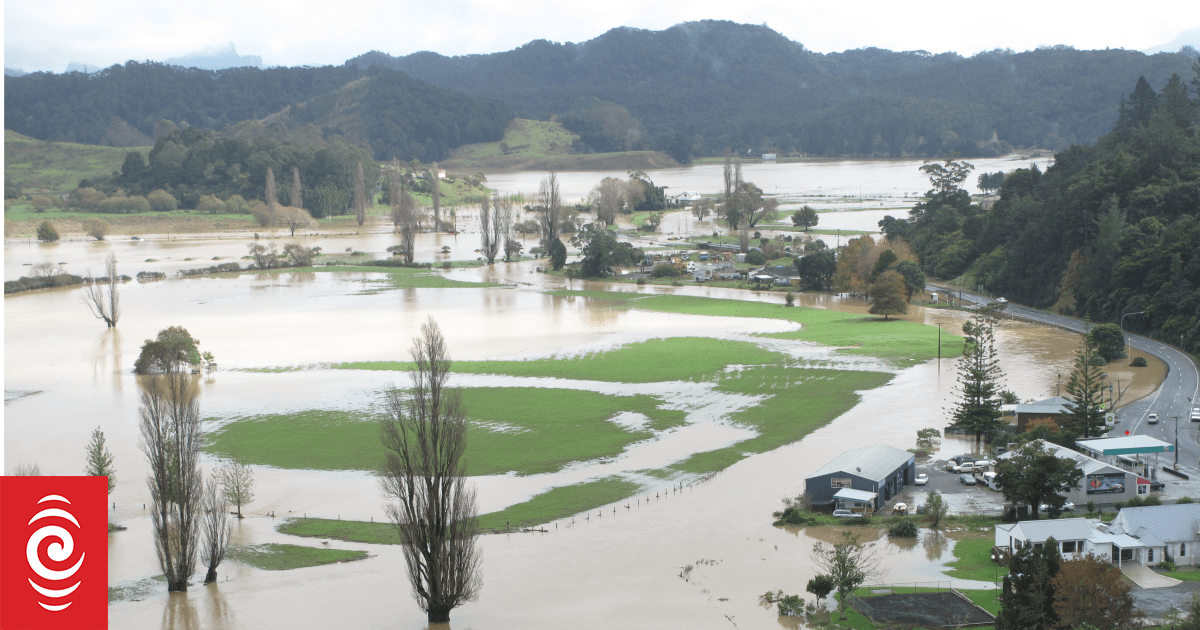
Homeowners in Kāeo, in the Far North, have in the past received financial help to raise their homes out of reach of floodwaters – but the current scheme is a straight buy-out of the district’s most dangerous properties.
Photo: RNZ / Peter de Graaf
A Far North couple whose home is repeatedly flooded in heavy rain says a council buy-out scheme could finally bring an end to years of stress and suffering.
The Far North District Council is considering opting in to the government scheme, which would see the council and central government split the cost of buying out desperate home owners.
The scheme is open only to homes damaged during the Cyclone Hale, Cyclone Gabrielle and the Anniversary Weekend floods – the so-called North Island Weather Events of 2023 – and only if those homes continue to pose an “intolerable risk” of death or injury in future floods.
A Whangaroa couple, who did not want to be identified, said their property had flooded many times since they bought it 11 years ago.
Cyclone Gabrielle was only the most recent incident.
“Our road was closed and we had water around our house for three days, the piles sunk on the house, we lost chickens and piglets, we lost all communication, there was no power, we couldn’t get cellphone reception… we were just left in the dark,” the man said.
The couple were insured but after a previous flood in 2018 they were told they would get only one more payout – so they could not make a claim unless the house was completely destroyed.
The man said the latest damage was repairable, but that would last only until the next flood.
He said the previous owners should not have been given consent to put a house in that location. Now they were stuck and unable to sell.
He said they loved the area and did not want to leave – but if the council offered to buy up flood-affected homes, they would have to accept.
“A buyout scheme’s a good idea. We can’t carry on living here, it’s dangerous, it floods way too often. We can’t live with the continual flooding and the risk to our lives.”
Now, Far North councillors are considering joining the likes of Auckland, Tairāwhiti and Masterton in the government’s Future of Severely Affected Land (FOSAL) voluntary buyout scheme.
Assessors are currently inspecting homes to see if they qualify as Category 3, meaning they are a danger to human life.
Speaking to a recent Far North District Council meeting, climate resilience manager Esther Powell said up to 21 homes could be affected, but the number could end up being as low as two.
That meant the cost to ratepayers was as yet uncertain.
The council’s share of the cost would be $5.9 million if all 21 homes qualified and their owners opted to take part in the buyout.
It could also be as low as $700,000 if just two properties were involved.
A change in the scheme’s closing date to mid-2025 meant work had to move quickly.
Powell said the cost, and number of homes involved, would be presented to the November meeting so councillors could decide whether to proceed.
Deputy mayor Kelly Stratford said it was the first time a government had up a scheme like it.
It was a rare chance to prevent future loss of life, as had happened in Waikare when people died trying to reach their homes during floods in 2009 and 2014.
“This might be the only opportunity that we will get, to address some of these dangerously located houses … We could keep doing the same thing, which is nothing. Or we can take up this opportunity to change the lives of whānau that have been repeatedly impacted,” she said.
Councillor Ann Court said she was “hugely sympathetic” to affected home owners, but worried about the precedent that could be set.
She also questioned why the government was singling out one weather event, given that Northland had been subject to many storms in the past – and they were only likely to get worse in future.
“This will be the first of many weather events that we will face as the weather changes, coupled with managed retreat in the face of climate change. So asking the ratepayers to fork out for this one event raises concerns in my mind that it will commit us to asking the ratepayers to fund more weather-related buyouts in future,” she said.
Asked about the potential cost of a buyout, the Whangaroa couple said there were no complaints in 2007 when the government, councils and home owners split the costs of raising homes in flood-hit Kāeo.
They said their preference would be to stay and raise their home above flood level, but that was not an option under the current scheme.
Meanwhile, the woman said she would continue to be anxious any time it rained.
“If I’m at work I’m worrying about my husband, how he is – if he’s ok, is the property OK, are the animals OK? Am I going to get home? Do I leave work early, just in case? Honestly, I’m not dealing with it very well.”
The government has set up a separate voluntary buyout scheme for whenua Māori [Māori land]. That scheme is fully government-funded, expect for the assessment process, which has to be carried out by the council.
It has been estimated 18 homes and marae on whenua Māori around the Far North could be eligible.
Northland’s other district councils, Whangārei and Kaipara, have opted out of the FOSAL buyback scheme.
Sign up for Ngā Pitopito Kōrero, a daily newsletter curated by our editors and delivered straight to your inbox every weekday.



